Digs & Discoveries
UPDATE: Mesolithic Baby Carrier
By JASON URBANUS
Tuesday, December 06, 2022
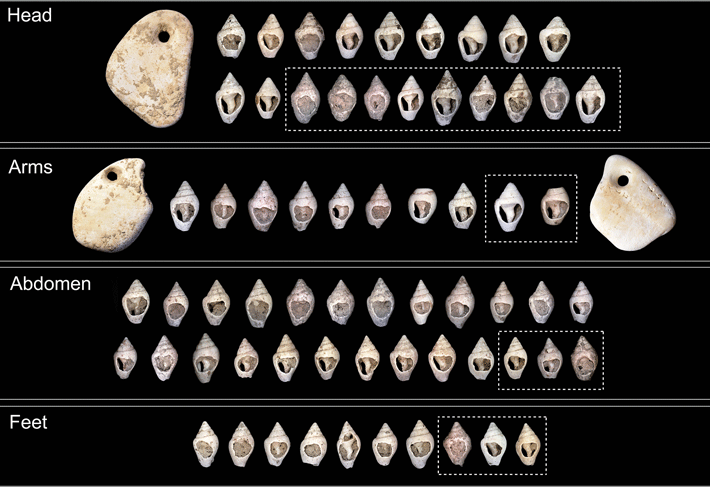 Archaeologists have learned more about the earliest known female infant burial in Europe, which was discovered several years ago. The remains of a Mesolithic girl were deposited in a shallow pit in the Arma Veirana Cave in Liguria, in northwest Italy, around 10,000 years ago. The discovery was noteworthy not only for its antiquity, but also because archaeologists found around 90 perforated shell beads and four large pendants in the girl’s grave. Using a variety of techniques, including 3-D photogrammetry and micro-CT scanning, the researchers have been able to re-create the layout of the child’s burial. The arrangement of the beads around the body suggests that they were sewn onto a garment that was wrapped around the baby’s body before she was interred. When she was alive, this garment likely functioned as a carrier or sling that would have allowed her parents to remain mobile—a necessity for Mesolithic hunter-gatherers—while keeping her close. “Archaeological traces of such an object are very difficult to gather, as a sling would need to be light and thus was likely made from materials that do not preserve well over time,” says Arizona State University archaeologist Claudine Gravel-Miguel.
Archaeologists have learned more about the earliest known female infant burial in Europe, which was discovered several years ago. The remains of a Mesolithic girl were deposited in a shallow pit in the Arma Veirana Cave in Liguria, in northwest Italy, around 10,000 years ago. The discovery was noteworthy not only for its antiquity, but also because archaeologists found around 90 perforated shell beads and four large pendants in the girl’s grave. Using a variety of techniques, including 3-D photogrammetry and micro-CT scanning, the researchers have been able to re-create the layout of the child’s burial. The arrangement of the beads around the body suggests that they were sewn onto a garment that was wrapped around the baby’s body before she was interred. When she was alive, this garment likely functioned as a carrier or sling that would have allowed her parents to remain mobile—a necessity for Mesolithic hunter-gatherers—while keeping her close. “Archaeological traces of such an object are very difficult to gather, as a sling would need to be light and thus was likely made from materials that do not preserve well over time,” says Arizona State University archaeologist Claudine Gravel-Miguel.
The beads and pendants may have served as amulets meant to protect the infant. The ornaments’ worn condition suggests that they were not made specifically for the baby, whose teeth indicate that she only lived for between 40 and 50 days, but had been used by the community for a considerable period of time. The archaeologists theorize that, because the carrier and pendants failed to protect the child, they were discarded and interred along with her remains so they couldn’t be reused in the future. (To read about the original discovery, see “Italy” in Around the World, March/April 2022.)
Etruscan Burial Crown
By JASON URBANUS
Tuesday, December 06, 2022
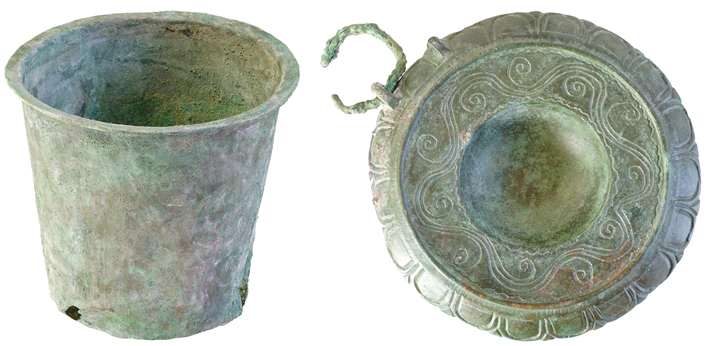
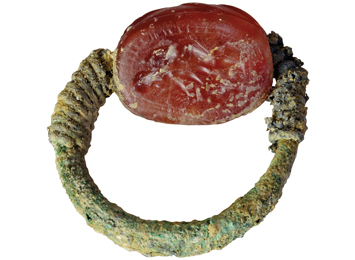 Researchers from the collaborative IMPERO project, which traces the movement of people along the Ombrone River in Tuscany, have unearthed a rare Etruscan grave that had remained undisturbed for 2,400 years. The discovery was made near the site of Podere Cannicci, which was an agricultural village and rural sanctuary in the late Etruscan and Roman Republican periods. The circular tomb, which measures five feet in diameter, was cut into a hillside and located just a foot beneath the surface.
Researchers from the collaborative IMPERO project, which traces the movement of people along the Ombrone River in Tuscany, have unearthed a rare Etruscan grave that had remained undisturbed for 2,400 years. The discovery was made near the site of Podere Cannicci, which was an agricultural village and rural sanctuary in the late Etruscan and Roman Republican periods. The circular tomb, which measures five feet in diameter, was cut into a hillside and located just a foot beneath the surface.
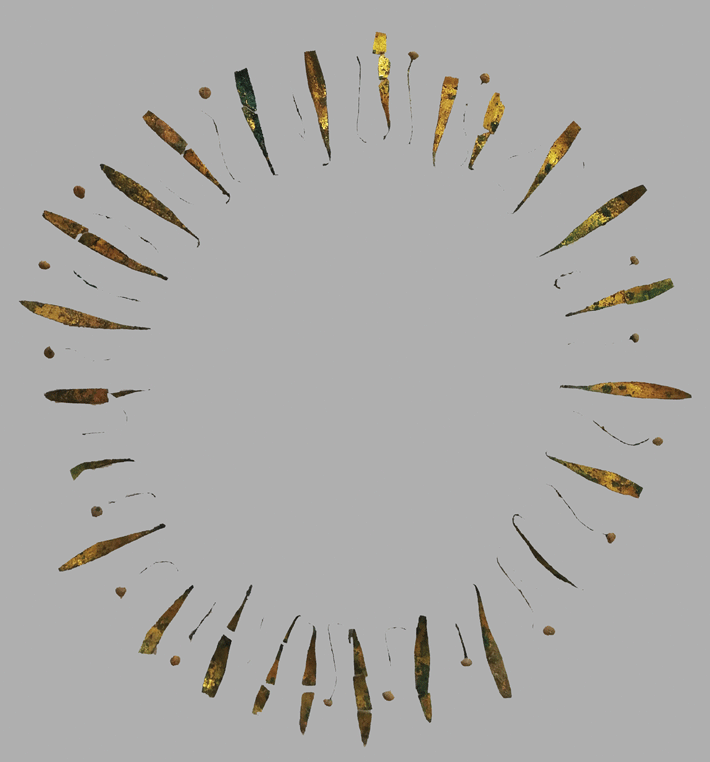 Although the Romans took control of the area around 294 B.C., the second-century B.C. grave is evidence that local inhabitants retained their Etruscan identity more than a century later. The burial included urns that held the cremated remains of two people who were interred with a full assemblage of ceramic vessels that represent a typical Etruscan funerary banquet. Other grave goods included gold earrings, bronze rings, and iron strigils, tools used to scrape the skin clean. The urn holding one individual, perhaps the patriarch of a wealthy local family, also contained a crown fashioned from gold-covered bronze olive leaves and pins. “The decoration pattern of the crown recalls these people’s engagement with agriculture, which was most likely their primary source of wealth,” says University at Buffalo archaeologist Alessandro Sebastiani. Researchers believe the second urn may have held the remains of the patriarch’s son.
Although the Romans took control of the area around 294 B.C., the second-century B.C. grave is evidence that local inhabitants retained their Etruscan identity more than a century later. The burial included urns that held the cremated remains of two people who were interred with a full assemblage of ceramic vessels that represent a typical Etruscan funerary banquet. Other grave goods included gold earrings, bronze rings, and iron strigils, tools used to scrape the skin clean. The urn holding one individual, perhaps the patriarch of a wealthy local family, also contained a crown fashioned from gold-covered bronze olive leaves and pins. “The decoration pattern of the crown recalls these people’s engagement with agriculture, which was most likely their primary source of wealth,” says University at Buffalo archaeologist Alessandro Sebastiani. Researchers believe the second urn may have held the remains of the patriarch’s son. 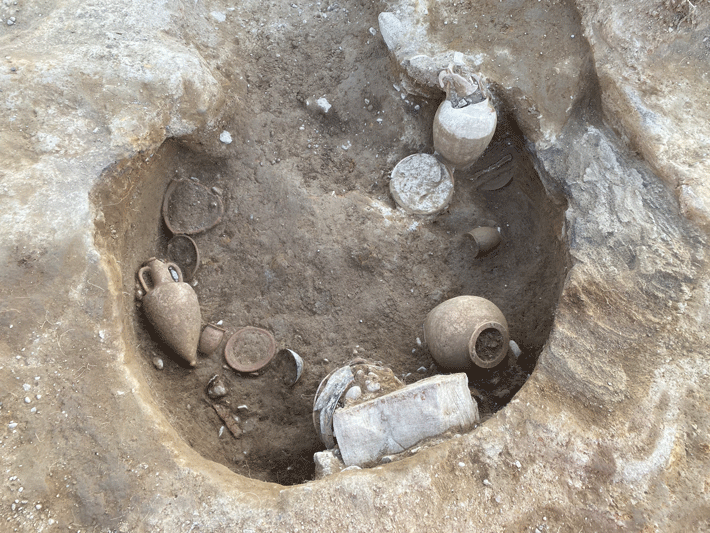
Off the Grid
By JASON URBANUS
Tuesday, December 06, 2022
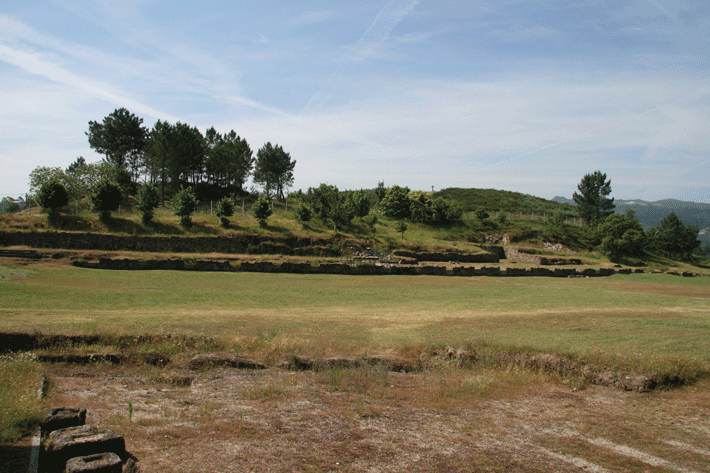 The small hilltop village of Freixo, Portugal, is an unassuming place. A single-lane stone-paved road runs through the heart of the settlement, where a dozen or so buildings spread out from a quaint church square. It is hard to imagine that 1,800 years ago, this was the location of Tongobriga, one of the largest Roman towns in northern Portugal, whose ancient population of 2,500 dwarfs the tiny number of residents today.
The small hilltop village of Freixo, Portugal, is an unassuming place. A single-lane stone-paved road runs through the heart of the settlement, where a dozen or so buildings spread out from a quaint church square. It is hard to imagine that 1,800 years ago, this was the location of Tongobriga, one of the largest Roman towns in northern Portugal, whose ancient population of 2,500 dwarfs the tiny number of residents today.
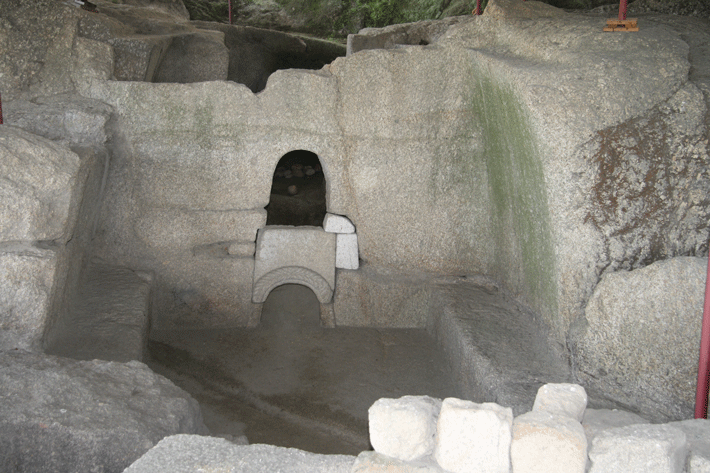 By the late twentieth century, much of the site’s past had disappeared beneath farmland, and stones that had once belonged to Roman buildings had been carted off to be used in new construction. The site’s forgotten history only began to be revealed in 1980, when archaeologists investigated an ancient wall that locals referred to as the “chapel of the Moors.” This wall turned out to be part of an extensive Roman bath complex. As excavations continued, archaeologists unearthed a sprawling Roman town that extended across 75 acres. They even learned its name, Tongobriga, from an inscription previously found at the site.
By the late twentieth century, much of the site’s past had disappeared beneath farmland, and stones that had once belonged to Roman buildings had been carted off to be used in new construction. The site’s forgotten history only began to be revealed in 1980, when archaeologists investigated an ancient wall that locals referred to as the “chapel of the Moors.” This wall turned out to be part of an extensive Roman bath complex. As excavations continued, archaeologists unearthed a sprawling Roman town that extended across 75 acres. They even learned its name, Tongobriga, from an inscription previously found at the site.
In the late first century A.D., about 100 years after the Romans had completed their conquest of the Iberian Peninsula, Tongobriga became an important regional administrative center. Befitting a town of its status, the city was laid out on a precisely gridded street plan with neighborhoods of Roman-style houses featuring atriums, as well as a theater, an amphitheater, and a large forum.
More recent excavations have revealed that the settlement’s history goes back even further. Prior to its Roman occupation, the site was inhabited by an Iron Age Celtic people known as the Castro culture. The Castro people lived in round stone houses, many examples of which have been uncovered beneath the ruins of the Roman town. These pre-Roman people left behind little to betray their presence apart from an Iron Age bath facility they carved out of the bedrock. As archaeologists continue to excavate at the site, they have come to believe that the Iron Age settlement was also quite significant, boasting a population of up to 2,000 people.
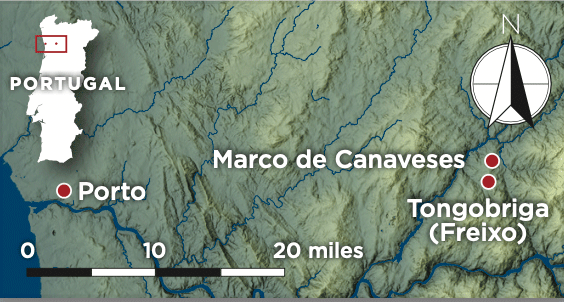 THE SITE
THE SITE
Tongobriga is easily reached from the city of Marco de Canaveses, which is located around two miles to the north. The highlight of any visit to the site is the exceptionally large Roman forum, which is bordered by the foundations of various commercial, religious, and administrative buildings. Along the forum’s north side, visitors can admire the Iron Age bath facility as well as the adjacent ruins of the Roman-era bath complex, which included a large swimming pool. During a stroll through the village of Freixo, the remnants of both Roman and pre-Roman houses can be seen lining the road. There is also a small interpretive center, which houses an exhibit examining how integration into the Roman Empire changed the lives of the area’s Indigenous population.
WHILE YOU’RE THERE
Tongobriga is located in the Douro Valley wine country. Several nearby vineyards along the well-touristed Rota dos Vinhos specialize in the local vinho verde and are open for visits and tastings.
A Young Hercules
By JASON URBANUS
Tuesday, December 06, 2022
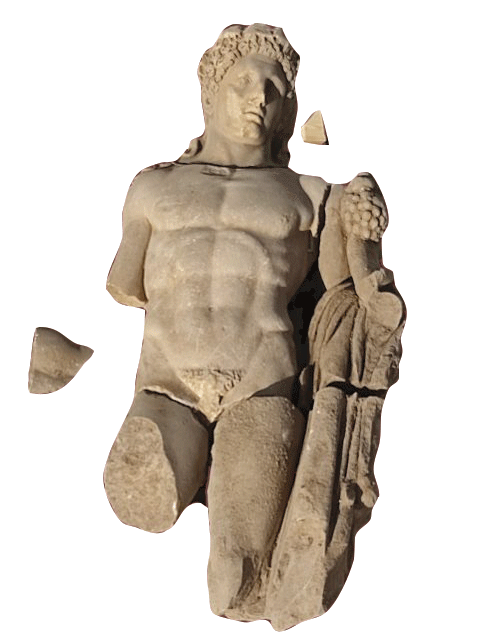 Archaeologists from the Aristotle University of Thessaloniki have unearthed a marble statue of a youthful Hercules in the ancient Greek city of Philippi. Philippi was originally called Crenides but was renamed after Alexander the Great’s father, Philip II of Macedon (reigned 359–336 B.C.), who conquered the city in 356 B.C. The larger-than-life sculpture, which dates to the second century A.D., during the Roman era, depicts the mythical hero with a much younger countenance than is typical—he usually appears bearded and more mature. It includes three of Hercules’ most common attributes—a lion pelt, a vine-leaf crown, and a club—making the statue’s intended identity clear. The discovery was made near an important intersection dating to the Byzantine era, where an ornately adorned building stood during the eighth or ninth century A.D. Although the statue had been created centuries earlier, it was reused as decoration for this new structure.
Archaeologists from the Aristotle University of Thessaloniki have unearthed a marble statue of a youthful Hercules in the ancient Greek city of Philippi. Philippi was originally called Crenides but was renamed after Alexander the Great’s father, Philip II of Macedon (reigned 359–336 B.C.), who conquered the city in 356 B.C. The larger-than-life sculpture, which dates to the second century A.D., during the Roman era, depicts the mythical hero with a much younger countenance than is typical—he usually appears bearded and more mature. It includes three of Hercules’ most common attributes—a lion pelt, a vine-leaf crown, and a club—making the statue’s intended identity clear. The discovery was made near an important intersection dating to the Byzantine era, where an ornately adorned building stood during the eighth or ninth century A.D. Although the statue had been created centuries earlier, it was reused as decoration for this new structure.
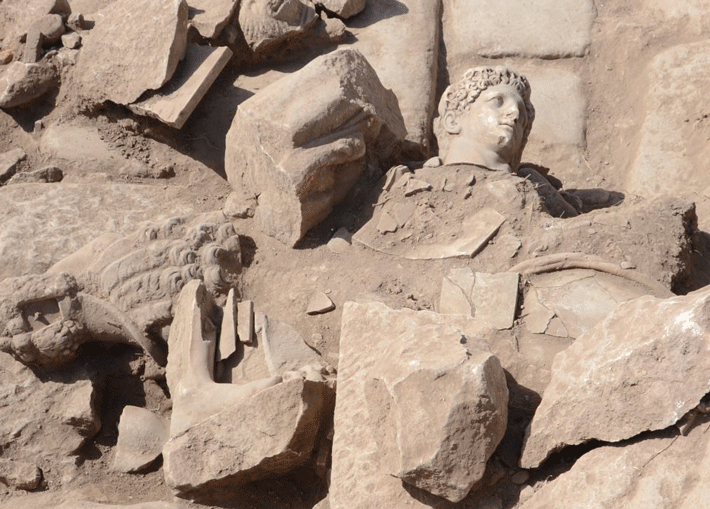
Advertisement
Page 2 of 2
Advertisement
IN THIS ISSUE
Advertisement

Recent Issues
-
 May/June 2024
May/June 2024
-
 March/April 2024
March/April 2024
-
 January/February 2024
January/February 2024
-
 November/December 2023
November/December 2023
-
 September/October 2023
September/October 2023
-
 July/August 2023
July/August 2023
-
 May/June 2023
May/June 2023
-
 March/April 2023
March/April 2023
-
 January/February 2023
January/February 2023
-
 November/December 2022
November/December 2022
-
 September/October 2022
September/October 2022
-
 July/August 2022
July/August 2022
-
 May/June 2022
May/June 2022
-
 March/April 2022
March/April 2022
-
 January/February 2022
January/February 2022
-
 November/December 2021
November/December 2021
-
 September/October 2021
September/October 2021
-
 July/August 2021
July/August 2021
-
 May/June 2021
May/June 2021
-
 March/April 2021
March/April 2021
-
 January/February 2021
January/February 2021
-
 November/December 2020
November/December 2020
-
 September/October 2020
September/October 2020
-
 July/August 2020
July/August 2020
-
 May/June 2020
May/June 2020
-
 March/April 2020
March/April 2020
-
 January/February 2020
January/February 2020
-
 November/December 2019
November/December 2019
-
 September/October 2019
September/October 2019
-
 July/August 2019
July/August 2019
-
 May/June 2019
May/June 2019
-
 March/April 2019
March/April 2019
-
 January/February 2019
January/February 2019
-
 November/December 2018
November/December 2018
-
 September/October 2018
September/October 2018
-
 July/August 2018
July/August 2018
-
 May/June 2018
May/June 2018
-
 March/April 2018
March/April 2018
-
 January/February 2018
January/February 2018
-
 November/December 2017
November/December 2017
-
 September/October 2017
September/October 2017
-
 July/August 2017
July/August 2017
-
 May/June 2017
May/June 2017
-
 March/April 2017
March/April 2017
-
 January/February 2017
January/February 2017
-
 November/December 2016
November/December 2016
-
 September/October 2016
September/October 2016
-
 July/August 2016
July/August 2016
-
 May/June 2016
May/June 2016
-
 March/April 2016
March/April 2016
-
 January/February 2016
January/February 2016
-
 November/December 2015
November/December 2015
-
 September/October 2015
September/October 2015
-
 July/August 2015
July/August 2015
-
 May/June 2015
May/June 2015
-
 March/April 2015
March/April 2015
-
 January/February 2015
January/February 2015
-
 November/December 2014
November/December 2014
-
 September/October 2014
September/October 2014
-
 July/August 2014
July/August 2014
-
 May/June 2014
May/June 2014
-
 March/April 2014
March/April 2014
-
 January/February 2014
January/February 2014
-
 November/December 2013
November/December 2013
-
 September/October 2013
September/October 2013
-
 July/August 2013
July/August 2013
-
 May/June 2013
May/June 2013
-
 March/April 2013
March/April 2013
-
 January/February 2013
January/February 2013
-
 November/December 2012
November/December 2012
-
 September/October 2012
September/October 2012
-
 July/August 2012
July/August 2012
-
 May/June 2012
May/June 2012
-
 March/April 2012
March/April 2012
-
 January/February 2012
January/February 2012
-
 November/December 2011
November/December 2011
-
 September/October 2011
September/October 2011
-
 July/August 2011
July/August 2011
-
 May/June 2011
May/June 2011
-
 March/April 2011
March/April 2011
-
 January/February 2011
January/February 2011
Advertisement






